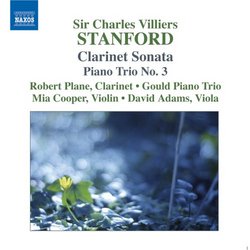| All Artists: Charles Villiers Stanford, Gould Piano Trio, Benjamin Frith Title: Stanford: Clarinet Sonata; Piano Trio No. 3 Members Wishing: 0 Total Copies: 0 Label: Naxos Original Release Date: 1/1/2007 Re-Release Date: 8/28/2007 Genre: Classical Styles: Chamber Music, Historical Periods, Classical (c.1770-1830), Instruments, Reeds & Winds Number of Discs: 1 SwapaCD Credits: 1 UPC: 747313041671 |
Search - Charles Villiers Stanford, Gould Piano Trio, Benjamin Frith :: Stanford: Clarinet Sonata; Piano Trio No. 3
 | Charles Villiers Stanford, Gould Piano Trio, Benjamin Frith Stanford: Clarinet Sonata; Piano Trio No. 3 Genre: Classical |
Larger Image |
CD Details |
CD ReviewsChamber Music in a Brahmsian Mold J Scott Morrison | Middlebury VT, USA | 09/22/2007 (5 out of 5 stars) "Like his idol, Johannes Brahms, Anglo-Irish composer Charles Villiers Stanford (1852-1924) wrote a number of chamber pieces that made use of the clarinet. All the works on this CD do feature the clarinet except for the disc's final piece, the Piano Trio No. 3. Interestingly, one of the works here, the Three Intermezzi for Clarinet and Piano, Op. 13, was written in 1879, several years before Brahms began incorporating that instrument into his chamber works. Otherwise, though, these works are late in Stanford's oeuvre, after his music began to seem old-fashioned. We need be thankful, given the autumnal beauty of these works, that Stanford continued writing in his wonted style even after the British music establishment had begun ignoring his work.
The Three Intermezzi were published as being for either violin and piano or clarinet and piano, but Stanford made it clear that he preferred the latter instrumentation. The first of the three pieces, Andante espressivo, has a lively middle section but the overall feeling of the piece is one of gentle melancholy. The opening section of No. 2, Allegro agitato, gallops along in D Minor before reaching the relatively calmer middle section in B Flat Major. No. 3 almost sounds Gypsy-Hungarian -- another Brahmsian influence? -- with the clarinet and piano trading arpeggios. The Clarinet Sonata, Op. 129, is from 1911 -- it's hard to believe this is from the same period as 'Rite of Spring' and 'Petrouchka' -- begins with a sonata allegro that is perhaps the most Brahmsian music on the disc. The middle movement has a subtitle, 'Caoine', Irish for 'Keen' (as in 'to keen'), and is a heartrending lament with the piano imitating the Irish harp. Lovely. The finale is an Allegretto that begins with lively cross-rhythms until the middle section which makes expert use of the clarinet's chalumeau register. The ending is hushed and serene. The two Fantasies for Clarinet and String Quartet (1921 and 1922 respectively) were probably written for student performance at the Royal College of Music where Stanford was professor of composition for many years. They were never published until 1996. Each is in three movements played without pause. It is, of course, no surprise that they reminds us texturally of Brahms's Clarinet Quintet, Op. 115. They are somewhat lighter in nature and do achieve the emotional depths of their forebear, sounding at times more like Schumann. But they are genuinely important additions to the clarinet quintet literature. The Third Piano Trio, Op. 158, is from 1918 and was written in memory of a colleague's two sons who had just been killed in the Great War. It is subtitled 'Per astra ad aspera' ('To the stars through struggle') and is characterized by dramatic gestures, especially in the first and last movements. The piano writing is Brahmsian in the extreme, reminding one at times of the Master's two piano concerti. The middle movement is both sad and resolute. The finale has a bit more optimism than the earlier movements and concludes with a marvelous fugal passage just before the triumphant coda. It is claimed that this is the Trio's first recording. Performers here are the excellent Robert Plane, clarinet, the Gould Piano Trio (Lucy Gould, violin; Alice Neary, cello; Benjamin Frith, piano) as well as Mia Cooper, violin, and David Adams, viola, in the Fantasies. One cannot speak highly enough of these players, who clearly love and understand this music. Obviously Stanford is not quite at the same exalted level as Brahms, but he certainly comes close at times; the music is filled with tuneful melodies, expert form and rhythmic vitality. This is indeed a worthy issue. Scott Morrison" |
